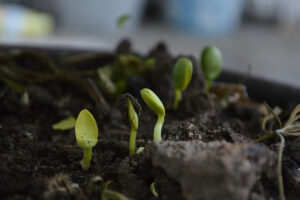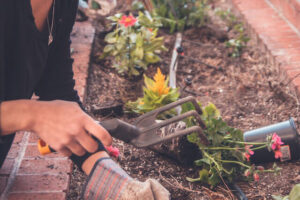Flowers
Hot Weather Gardening Tips
Gardening enthusiasts in the UK know that dealing with scorching hot weather can present a significant challenge.
However, with a dash of knowledge and the right adjustments, your garden can not only survive but thrive in the midst of extreme heat.
💡 Understanding the nuances of hot weather gardening and tailoring your practices accordingly will ensure that your cherished plants and blossoms remain healthy and vibrant even when the sun blazes relentlessly.
In this article, we delve into ten expert tips to help you confidently embrace hot weather summer gardening and create a flourishing oasis in the midst of the summer heat.
I. Understanding Hot Weather Gardening
As the sun blazes high in the sky and temperatures soar, hot weather gardening demands a different approach to ensure your green space continues to flourish.
To navigate the challenges of gardening in scorching conditions, it is crucial to comprehend the nuances of hot weather gardening and the impact extreme heat can have on your plants and soil.
Importance of Adapting Gardening Practices
To master the art of hot weather gardening, one must first recognize the necessity of adjusting traditional gardening techniques.
The relentless onslaught of extreme heat can wreak havoc on plants and soil, leading to stress-induced withering and rapid dehydration.
By adopting a more adaptive approach, gardeners can cultivate a resilient garden thriving landscape that triumphs over the challenges of hot weather.
Impact of Extreme Heat on Plants and Soil
Prolonged exposure to scorching temperatures can have a profound impact on the well-being of your garden.
Lush leaves may droop, once vibrant flowers can lose their luster, and the once-moist soil can dry out at an alarming rate.
Understanding how heat affects your garden ecosystem empowers you to make informed decisions that safeguard and nourish your green sanctuary.
II. Preparing Your Garden for Hot Weather
With the sun’s fiery rays beating down, preparing your garden for hot weather becomes a paramount task to ensure its resilience and vibrancy during the scorching summer months.
As the temperatures soar, your green sanctuary faces increased challenges in retaining moisture, providing essential nutrients, and shielding delicate plants from sunburn.
However, fear not, for with the right preparations, you can create a garden that thrives even in the midst of extreme heat.
Soil Preparation and Mulching
Embark on your hot weather gardening odyssey by meticulously preparing the soil. Infuse it with organic matter to bolster its water retention capabilities, ensuring it can withstand the arid conditions ahead.
Embrace the virtues of mulching, an invaluable technique to conserve soil moisture, stifle the growth of stubborn weeds, and maintain optimal soil temperatures.
Proper Watering Techniques
Water is the lifeblood of any garden, and during hot, dry weather here, it becomes an invaluable resource.
Adopting proper watering techniques is paramount to your garden’s survival.
Deep, infrequent watering encourages plants to develop robust root systems that can penetrate deep into the soil, accessing vital moisture reserves.
Employing drip irrigation or soaker hoses is a smart choice, providing targeted watering to minimize wastage through evaporation.
Choosing Heat-Tolerant Plants
Selecting the right flora for your garden can spell the difference between a wilting wasteland and a flourishing haven.
Seek out heat-tolerant plant varieties, nature’s conquerors of scorching temperatures, who can endure the soaring heat while still proudly displaying their magnificence.
Embrace the beauty and hardiness of drought-resistant plants, ensuring your garden remains resplendent even during dry spells.
Providing Shade and Windbreaks
Crafting a strategic oasis of shade in your garden serves as a protective refuge for delicate and precious plants & flowers even during the blazing heat of the day.
Ingeniously place shade structures like trellises or arbors to shield your floral beauties from direct sunlight and potential sunburn.
Consider the benefits of windbreaks, such as well-placed hedges or sturdy fences, which shield your garden from the harsh winds that often exacerbate moisture loss.
III. 10 Essential Hot Weather Gardening Tips
Tip 1: Watering Effectively

When it comes to gardening in hot weather, watering effectively is of paramount importance.
In the scorching heat, plants and flowers become more vulnerable to dehydration, making it essential to establish a consistent watering schedule.
The best times to water your garden are during the early morning or late evening hours when the temperatures are relatively cooler, and evaporation rates are lower.
This ensures that your plants have ample moisture to withstand the heat throughout the day.
Tip 2: Mulching for Moisture Retention

Mulching is a game-changer in hot weather gardening, providing a natural shield against the relentless sun.
Apply a generous layer of organic mulch around your plants to create a protective barrier that conserves soil moisture and regulates temperature.
Mulch not only prevents water from evaporating too quickly but also suppresses the growth of pesky weeds, giving your plants a competitive edge in accessing vital nutrients and moisture.
Tip 3: Protecting Plants from Sunburn

Just like our skin, plants can suffer from sunburn in intense heat.
To shield your precious greenery, identify vulnerable plants that are more susceptible to sunburn and provide them with protective measures.
Shade cloth or row covers can be strategically positioned to shield delicate foliage from direct sunlight, preventing sunburn and promoting healthier growth.
Tip 4: Providing Adequate Ventilation

Proper air circulation is vital for maintaining plant health and mitigating the risk of heat stress and fungal diseases.
Mindfully arrange your plants to allow ample space between them, facilitating optimal ventilation.
Additionally, consider using gentle fans to promote air movement or take advantage of prevailing natural wind patterns to provide a gentle breeze for your garden’s well-being.
Tip 5: Fertilising Appropriately

In hot weather, plants have specific nutrient requirements to endure the challenging conditions.
Opt for slow-release fertilizers that provide a steady supply of essential nutrients without overwhelming your plants during heatwaves.
A well-balanced fertilization routine will ensure that your garden remains healthy and vibrant despite the scorching temperatures.
Tip 6: Implementing Proper Pruning Techniques

Pruning is a valuable technique to reduce stress on your plants and encourage better airflow.
Trim back overgrown branches and foliage to allow more sunlight to penetrate, reducing shade in the garden and preventing excessive moisture retention.
Proper pruning also aids in shaping the plants, promoting healthy growth patterns, and mitigating potential damage caused by heavy winds or storms.
Tip 7: Pest and Disease Management in Hot Weather

Hot climates can attract various pests and diseases, making pest and disease management essential in hot weather gardening.
Embrace natural pest control methods to safeguard your garden’s ecosystem and nip potential infestations in the bud.
Regular monitoring and early detection are key to preventing pests and diseases from wreaking havoc on your flourishing garden.
Tip 8: Selecting Heat-Tolerant Plants

One of the most effective strategies for hot weather gardening is to choose plants that can withstand and even thrive in the searing heat.
Explore a wide range of heat-tolerant plant varieties, each boasting unique beauty and resilience.
Additionally, opt for drought-resistant plants that possess remarkable water-saving adaptations, ensuring your garden remains lush even during dry spells.
Tip 9: Timing Your Gardening Activities

Mastering the art of timing is critical for successful hot weather gardening.
Plan your gardening activities during the cooler parts of the day, such as early morning or late afternoon, to avoid working in the peak heat.
This not only protects you from heat-related ailments but also allows your plants to recover and absorb water more effectively.
Tip 10: Properly Maintaining Lawns in Hot Weather

Your lawn deserves special attention during hot weather.
Employ proper watering practices, ensuring deep and infrequent watering to promote strong root growth.
Adjust your mower height to avoid stressing the grass and consider aerating and overseeding as necessary to revitalize and fortify your lawn.
By applying these essential hot weather gardening tips, you can arm your garden with the resilience it needs to flourish in the scorching heat.
Embrace the challenges of hot weather gardening and watch your garden thrive vibrantly, defying the relentless summer sun.
IV. Additional Hot Weather Gardening Considerations
Gardening in hot weather demands more than just green thumbs and enthusiasm.
As the sun beats down relentlessly, taking extra measures to protect your garden and yourself becomes paramount.
In this section, we explore essential considerations that will fortify your gardening endeavors during scorching temperatures.
Importance of Personal Protection
Venturing into the realm of hot weather gardening necessitates mindful care of oneself.
Equip yourself with sun protection gear, such as a wide-brimmed hat, sunglasses, and sunscreen, shielding you from the sun’s relentless rays.
Hydration is key to your well-being, so keep your body replenished with plenty of water, and take well-deserved breaks during peak afternoon heat up hours to avoid succumbing to heat exhaustion.
Gardening in Containers and Raised Beds
Embrace the versatility of container gardening, a brilliant solution for hot weather conditions.
Choose containers with excellent drainage and select heat-resistant plants, cultivating your botanical haven in style.
Raised flower beds offer even more advantages, with improved drainage and warmer soil temperatures, a recipe for successful cultivation in heat-prone regions.
What are the best watering practices for my plants?
Water plants in the early morning or late evening to minimize water evaporation. Consider using drip irrigation or soaker hoses for targeted watering, especially during hot days.
Can I use grass clippings as mulch in hot weather?
Yes, grass clippings can be used as mulch around your plants during hot weather.They act as a natural mulch, retaining moisture and providing nutrients as they break down.
Should I place a bird bath in my garden during hot weather?
Having a bird bath in your garden can be helpful during hot weather. Birds will visit the bath to cool off and may also help control insect populations in your garden.
How can I protect my plants on an exceptionally hot day?
On extremely hot days, consider providing additional shade using temporary structures or shade cloth. Water your plants more frequently to keep them hydrated.
Can you share some other helpful tips for hot weather gardening?
Along with the tips provided, make sure to choose heat-tolerant plant varieties, adjust your gardening schedule to avoid peak heat hours, and use slow-release fertilizers to nourish your plants without causing stress.
Is the type of soil important for hot weather gardening?
Yes, the soil type plays a crucial role in hot weather gardening. Soil with good drainage and moisture retention abilities is preferred, as it helps plants cope with the challenges of extreme heat.
Hot Weather Gardening Conclusion:
Gardening enthusiasts need not shy away from the challenges of hot weather; armed with 10 expert tips for gardening here, your garden will flourish in the sizzling heat of the UK summers.
Adapt your gardening practices, water wisely, safeguard your cherished plants, and embrace the resilience of heat-tolerant varieties to witness your garden defy the odds and bloom majestically even amidst extreme heat.
As you traverse the journey of hot weather gardening, always remember that continuous learning and adaptability are the cornerstones of success in nurturing your thriving garden sanctuary.
So, step boldly into your horticultural adventure, and may your garden thrive gloriously, even in the fiercest embrace of summer’s scorching sun. Happy gardening!
FAQs – Hot Weather Gardening Tips
Q. How often should I water plants during hot weather?
A. Generally, it is recommended to water plants deeply 1-2 times per week during hot weather.
This allows the water to penetrate the plant roots effectively and encourages the development of a strong root system.
Q. What type of potting soil is best for hot weather gardening?
A. Opt for a potting soil mix that has good moisture retention properties, as this helps plants stay hydrated for longer periods.
Look for a soil blend that contains organic matter to enhance water retention.
Q. How deep should I water to reach the plant roots?
A. Watering to a depth of 1-4 inches is ideal to ensure that water reaches the plant roots.
This encourages the roots to grow deeper into the soil, making the plants more resilient to drought conditions.
Q. Should I apply a thick layer of mulch around my plants?
A. Yes, applying a thick layer (about 1-2 inches) of mulch around your plants is beneficial during hot weather.
Mulch helps to retain soil moisture, regulate soil temperature, and prevents weed growth.
Q. How can I prevent leaf burn in my garden?
A. To prevent leaf burn, provide shade for susceptible plants using shade cloth or row covers.
Avoid planting heat-sensitive species in direct sunlight during the hottest parts of the day.

